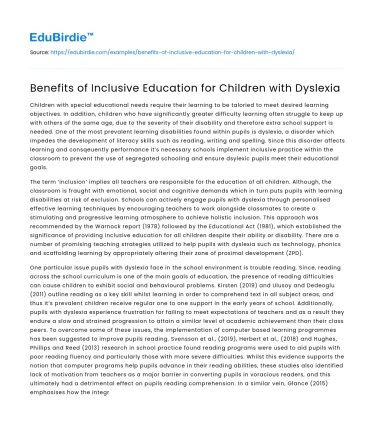Children with special educational needs require their learning to be taloried to meet desired learning objectives. In addition, children who have significantly greater difficulty learning often struggle to keep up with others of the same age, due to the severity of their disability and therefore extra school support is needed. One of the most prevalent learning disabilities found within pupils is dyslexia, a disorder which impedes the development of literacy skills such as reading, writing and spelling. Since this disorder affects learning and consqeuently performance it’s necessary schools implement inclusive practice within the classroom to prevent the use of segregated schooling and ensure dsylexic pupils meet their educational goals.
The term ‘inclusion’ implies all teachers are responsible for the education of all children. Although, the classroom is fraught with emotional, social and cognitive demands which in turn puts pupils with learning disabilities at risk of exclusion. Schools can actively engage pupils with dyslexia through personalised effective learning techniques by encouraging teachers to work alongside classmates to create a stimulating and progressive learning atmosphere to achieve holistic inclusion. This approach was recommended by the Warnock report (1978) followed by the Educational Act (1981), which established the significance of providing inclusive education for all children despite their ability or disability. There are a number of promising teaching strategies utilized to help pupils with dyslexia such as technology, phonics and scaffolding learning by appropriately altering their zone of proximal development (ZPD).
Save your time!
We can take care of your essay
- Proper editing and formatting
- Free revision, title page, and bibliography
- Flexible prices and money-back guarantee
One particular issue pupils with dyslexia face in the school environment is trouble reading. Since, reading across the school curriculum is one of the main goals of education, the presence of reading difficulties can cause children to exhibit social and behavioural problems. Kirsten (2019) and Ulusoy and Dedeoglu (2011) outline reading as a key skill whilst learning in order to comprehend text in all subject areas, and thus it’s prevalent children receive regular one to one support in the early years of school. Additionally, pupils with dyslexia experience frustration for failing to meet expectations of teachers and as a result they endure a slow and strained progression to attain a similar level of academic achievement than their class peers. To overcome some of these issues, the implementation of computer based learning programmes has been suggested to improve pupils reading. Svensson et al., (2019), Herbert et al., (2018) and Hughes, Phillips and Reed (2013) research in school practice found reading programs were used to aid pupils with poor reading fluency and particularly those with more severe difficulties. Whilst this evidence supports the notion that computer programs help pupils advance in their reading abilities, these studies also identified lack of motivation from teachers as a major barrier in converting pupils in voracious readers, and this ultimately had a detrimental effect on pupils reading comprehension. In a similar vein, Glance (2015) emphasises how the integration of technology in primary schools is ineffective in improving outcomes for all pupils due to inconsistent teaching training and thus this intervention poses constraints as a effective method of ‘customized instruction’ for children’s development in the present day.
Another primary problem children with dyslexia encounter is difficulties with phonemic awareness, which hinders spelling and word reading efficiency. The tutoring of sound-symbol association (e.g phonics) targets difficulty in identifying sounds in spoken words and overall weaves literacy into the classroom. Moreover, a study found pupils with dyslexia have a higher propensity for creative thinking, than normal developing students. In consideration of this, teachers have embraced sensory activities such as flashcards to further develop pupils' acquisition of vocabulary and spelling. In essence, the use of flash card learning sustained the attention of all pupils and in turn succesffully encouraged active recall of factual knowledge. However, despite this development educational critics argue there is insufficient evidence to suggest that such an approach is favorable for children with dyslexia transitioning into early adolescence, as a majority studies were deprived of repeated observations, whilst the learning disorder is classified as a long term condition.
Developmental psyhcologist Vygotsky (1978) proposes social interaction is vital in the development of children’s cognition. It’s through ‘social interaction’ children learn from each other. These notions form the basis of what Vygotsky has termed as the ‘zone of proximal development’ (ZPD) which illustrates children’s learning can be efficiently amplified with the assistance of classmates and adults. With regards to children with dsylexia, the role of support staff is vital in promoting and supporting an inclusive school environment. Educational researchers found the presence of learning mentors in mainstream classrooms allowed dyslexic pupils to enhance their learning experiences by extending their comprehension beyond classroom teaching and hence work towards the expected level of development of their age group. Even though this approach appears to show radical change in the inclusive education sector, pupils with dyslexia may obtain constant academic support from learning mentors than other pupils in the classroom,which can be recognised as school segregation and ultimately disrupt the educational progress of peers. Nevertheless, studies reveal collaborative learning is another educational strategy, that could improve classroom teaching and meet the needs of dsylexic pupils. Working collaboratively delivers learning opportunities that have specific advanatges for children with dyslexia, as it exposes them to the individual perceptions that others may have with a situation or problem. This reflects the different abilities of group members and the make for an ‘interactive exchange’ helps deepen and broaden all children’s understanding. Although, reserach indicates individual differences in groups may confound the effect of social learning and thus provoke the possibility of an unwilling participation by pupils in school affairs (Denscombe, 2014). In terms of children with dyslexia, they may detach themselves from interacting with other children and as a result develop mental health difficulties.
And lastly, educational practitioners propose secure attachments with parents promotes a child’s social development.






 Stuck on your essay?
Stuck on your essay?

